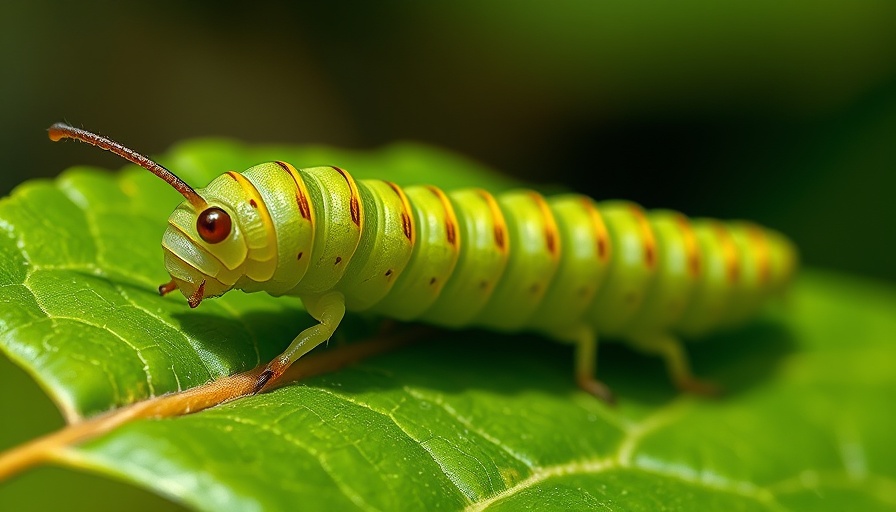
Understanding Armyworms: The Elusive Garden Invaders
For many gardeners, the sight of creeping pests can induce panic, particularly when they resemble an army marching through your patch of green. Armyworms are the larvae of various moth species and can wreak havoc on your plants, from grasses to an array of vegetables. These pests are not picky, and their insatiable appetites mean they can obliterate garden harvests in a matter of days if left unchecked.
Identifying Armyworms: Signs and Characteristics
Armyworms are identified primarily by their physical appearance, which includes their chunky caterpillar-like bodies that usually measure about an inch to an inch and a half long. They are generally brown and might have stripes or patterns that make them blend in with the environment. During the day, they hide in the soil or beneath leaves, emerging at dusk to feed. A tell-tale sign of an armyworm infestation is the rapid loss of plant foliage and an unusual appearance of damaged leaves.
The Life Cycle: How Armyworms Multiply
Understanding the biological and life cycle stages of armyworms is crucial for effective management. They typically undergo a complete metamorphosis: from egg to larva (the armyworm stage), then pupating into a moth before becoming adults. Moths can travel long distances to lay their eggs, contributing to widespread outbreaks. Notably, the Fall Armyworm (Spodoptera frugiperda), particularly common in eastern North America, is notorious for migrating, making it even more imperative to be vigilant.
Organic Control Methods for Armyworm Infestations
Taking a proactive approach is key to managing armyworms organically. Begin by employing cultural control methods: keep your garden clean and well-maintained and practice crop rotation. Choosing pest-resistant plants and implementing regular monitoring can dramatically decrease the chances of an infestation. For instance, nurturing companion plants that deter pests can enhance your garden's resilience. These techniques not only combat armyworms but contribute to a healthier ecosystem overall.
Effective Biological Control Techniques
In addition to cultural controls, biological control methods prove invaluable. Introducing beneficial organisms, such as parasitic wasps that target armyworm larvae, can help keep populations in check. Similarly, leveraging entomopathogenic nematodes—tiny roundworms that kill pests in the soil—can also minimize damage. Such strategies embrace the diversity of life in your garden, ultimately fostering a vibrant and balanced ecosystem.
When to Use Organic Pesticides: A Thoughtful Approach
In some cases, resorting to organic pesticides may become necessary. When selecting a product, look for ones that specifically target armyworms without harming beneficial insects. Options such as Bacillus thuringiensis (Bt) have proven effective and can be safely used in organic gardens. Always remember to follow application guidelines carefully to avoid adverse impacts on your garden's health.
Beyond Armyworms: A Holistic Gardening Perspective
Managing armyworms effectively paints part of the larger picture of responsible gardening. It involves understanding your plants and their interactions with surrounding wildlife. This holistic approach even extends to gardening techniques, from utilizing compost (to enrich your soil) to incorporating climate-friendly practices that support sustainability.
Building Community Through Gardening
As we cultivate our gardens, we also nurture our communities. Engaging with fellow gardeners can provide substantial insights and support during your battle with pests like armyworms. Sharing tips and tricks, or even hosting plant swaps, builds a network of knowledge that enriches everyone's gardening experience.
So, if you find yourself facing an armyworm invasion, remember that knowledge is your best ally. Whether utilizing organic practices or mobilizing your garden community, you hold the power to reclaim your green spaces and foster a thriving habitat for both plants and pollinators.
For those looking to delve further into the art of home gardening, explore various resources on pest management, from DIY gardening projects to growing vegetables that flourish in your unique environment. Empower yourself, and together we can cultivate not just gardens but a movement towards sustainable living.
Take Action Today!
Don’t let armyworms dictate your gardening results. Equip yourself with knowledge and make moves to protect your precious plants. Engage with your local gardening community, share your insights, and foster sustainable practices for the future of your garden!
 Add Row
Add Row  Add
Add 




 Add Row
Add Row  Add
Add 

Write A Comment